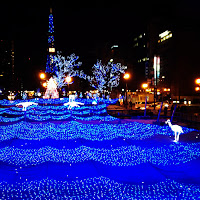I am on day 3 of the longest vacation of my life around the Kansai region of Japan. We left Yakumo, Hokkaido on December 27th, and after a 2 hr train ride, 2 hr plane ride with discount airline Fly Peach, a shuttle from Kansai Airport Terminal 2 to Terminal 1, a 40 min train ride to Osaka Namba station, and a 3 minute subway ride, we finally arrived at Osaka Hana Hostel. The hostel is located in the Minami chuo (South ward) and is a nice, clean, affordable place. International hostels are a reasonable way to travel.
Upon arrival, we ventured out into Amerikamura, the America-themed shopping/youth/fashion district. We ate at an Indian restaurant; the Japanese are quite fond of curry and there are a surprising number of Indian restaurants around, although this was our first time eating Indian food in Japan. I felt like a truly global citizen, as an American in Japan, speaking Japanese with our waiter, a chubby Indian man, who made us feel more comfortable by speaking a bit of English (probably his third language at least).
The next morning, we had a big and affordable American style breakfast at a place called Planet 3rd Cafe.
Upon arrival, we ventured out into Amerikamura, the America-themed shopping/youth/fashion district. We ate at an Indian restaurant; the Japanese are quite fond of curry and there are a surprising number of Indian restaurants around, although this was our first time eating Indian food in Japan. I felt like a truly global citizen, as an American in Japan, speaking Japanese with our waiter, a chubby Indian man, who made us feel more comfortable by speaking a bit of English (probably his third language at least).
The next morning, we had a big and affordable American style breakfast at a place called Planet 3rd Cafe.
Then, we walked to Tennoji Temple and Park, explored gardens and forests and experienced some of the religious New Year traditions: burning incense, lighting candles, and giving money as an offering.
Although I planned a daily itinerary, we wandered around and discovered most of the areas I wanted to visit. Dotombori Canal, Shin Sekai (New World District), and Shinsaibashi. There are many narrow, covered alleys with bright neon signs and restaurants, Pachinko Parlors, and restaurants, including the food Osaka is famous for: Kushi Katsu (fried pork cutlets) and Okonomiyaki (fried pancake type things).
Despite our many adventures, we still had time to take a nap and see Les Miserables, our first movie in Japan. Tickets were about about 2000yen, but concessions were noticibly cheap, and they offered several luxurious amenities like a tray for your popcorn and drink, blankets, and extra seat cushions. The movie was amazing. Tom and I recently watched Hugh Jackman in Oklahoma, and he put on the performace of a lifetime in Les Mis. Russell Crowe's performance left a bit to be desired, as his singing wasn't big screen ready. Sasha Baron Cohen (the Borat guy) and Helena Bonham Carter were the pinnacle of a comedic duo, and Amanda Seyfried and Anne Hathaway were less annoying than I thought they would be. The music was excellent, and I would wholeheartedly recommend seeing it! Tom really wants to see it again...but it's too expensive to go to it in the theaters again. Maybe when it comes out on DVD we can get it.
Although I planned a daily itinerary, we wandered around and discovered most of the areas I wanted to visit. Dotombori Canal, Shin Sekai (New World District), and Shinsaibashi. There are many narrow, covered alleys with bright neon signs and restaurants, Pachinko Parlors, and restaurants, including the food Osaka is famous for: Kushi Katsu (fried pork cutlets) and Okonomiyaki (fried pancake type things).
Despite our many adventures, we still had time to take a nap and see Les Miserables, our first movie in Japan. Tickets were about about 2000yen, but concessions were noticibly cheap, and they offered several luxurious amenities like a tray for your popcorn and drink, blankets, and extra seat cushions. The movie was amazing. Tom and I recently watched Hugh Jackman in Oklahoma, and he put on the performace of a lifetime in Les Mis. Russell Crowe's performance left a bit to be desired, as his singing wasn't big screen ready. Sasha Baron Cohen (the Borat guy) and Helena Bonham Carter were the pinnacle of a comedic duo, and Amanda Seyfried and Anne Hathaway were less annoying than I thought they would be. The music was excellent, and I would wholeheartedly recommend seeing it! Tom really wants to see it again...but it's too expensive to go to it in the theaters again. Maybe when it comes out on DVD we can get it.
Yesterday, we took a train to Nara, one of the most historic and famous places in Japan. 1,200 tame deer live in the park, feeding on the biscuits tourists buy for 150yen/pack. We saw Todai-ji (temple) and Kasuga Shrine. Compared to the bustling youth metropolis that is Osaka, Nara was quieter, full of more elderly people, and tourists in general. We enjoyed the forest, the deer, the Great Buddha, and the relaxing three-course Japanese style lunch we had with local pork and matcha (green tea) lattes with deer art drawn on top at Nara Cafe Youan.
And today, our last full day in the Minami area, we took two subway trains to the Osaka Aquarium. We are becoming quite savvy public transport travelers, even with maps and machines in Japanese! I wish you could see us. We're pretty pro, but it took us a fair number of mistakes and confusing conversations with transit officials to figure everything out. But I never told you that. The aquarium is one of the largest in the world, and luckily we accidentally arrived 30 minutes before it opened, putting us 3rd in line, followed by about 150 others waiting outside under our umbrellas. We beat a lot of the rush, on the Sunday before the New Year. It must be one of their busiest days of the year! Much of the aquarium is a winding path around a giant central tank, with fish big and small, sharks and manta rays and turtles and schools of silverfish, all interacting in a pseudo marine environment. We enjoyed seeing the sharks eat other fish in the tank, and the same species of fish riding along under and behind the shark, cannibal-eating the spit out remains of their bretheren. The circle of life...
Now, I must share these three anecdoes: One of the most surprising and enjoyable things about this trip has been the random encounters I've had with Japanese children . While most other tourists are going about their business, children are always interested in their environment, and the two friendly-looking white people (us) couldn't be more intriguing.
At a noodle restaurant yesterday, upon entering, a little girl sitting on a stool looked right up at me with the most sparking eyes and genuinely kind smile and said, "Yoi otoshio" which means, "Happy New Year," in the Kansai dialect. I was just smitten with her, and smiled, but I didn't say anything back because Tom was still walking and I was too startled! The girl and her parents ended up leaving about 30 seconds after us, and the girl yelled "Happy New Year" after us. What a doll.
I was raving to Tom about this sweet girl on the walk back to the hostel, when this barefoot old lady near a bike parking rack was frantically running about and yelling, "Onegaishimasu!" (Please!). This was on a busy sidestreet in Amemura, with cars and bikes whizzing by. It was then that we noticed a playful little puppy (who had likely snuck out of the apartment and took off down the street) weaving in and out of the bikes, play bowing, and trying to escape in a game of chase. Tom and I simultaneously, no questions asked, started helping this woman (while many other Japanese people stood around laughing at the crazy lady's fate and the 2 gaijin and pizza guy helping her). I ended up shooing it away from the street, and Tom grabbed the little puppy's rump and picked it up. The lady was soooo relieved and thankful, and Tom was beaming, having rescued (and touched) this adorable, fluffy puppy.
Finally, while waiting for the subway train from the aquarium today, I was playing DS, and a little boy walked in front of me in line. I looked at him like, "What do you think you're doing?" and he just smiled up at me and peeked over my shoulder at the DS. Later, on the subway, he and his mom sat across from Tom and I, and he kept looking over at me, getting out his DS. I play this game called "Street Pass" which allows me to wirelessly connect to other people's DSes and "meet them" to exchange puzzle pieces and have them be characters in this little RPG. I saw then that I had a "New Arrival" at my Street Pass Plaza Gate, and sure enough it was Kaito, a Japanese boy from Shimane in a purple shirt. I held the character up to the boy and there was a resemblance, and before I knew it, Tom was asking, "Kaito?" across the train. The mom said, "Hai, Kaito!" and I showed the boy his profile on my DS. He had already met me, I think, on his, and was amazed, smiling, and shy. In the game, it shows every country you meet someone from, and I may have been his first American! At the airport on the way to Osaka, waiting for our flight, I saw a child showing his parents the "Amerikajin" (American) on his DS. I have a cool Bowser hat in the game, so I'm representin,' no worries.
This afternoon we will take naps and try to find the Cat Cafe that we walked by yesterday (a coffee shop with a bunch of cats in it). Tomorrow we will take the train to Kita (north) for New Years. More updates to come!





















































